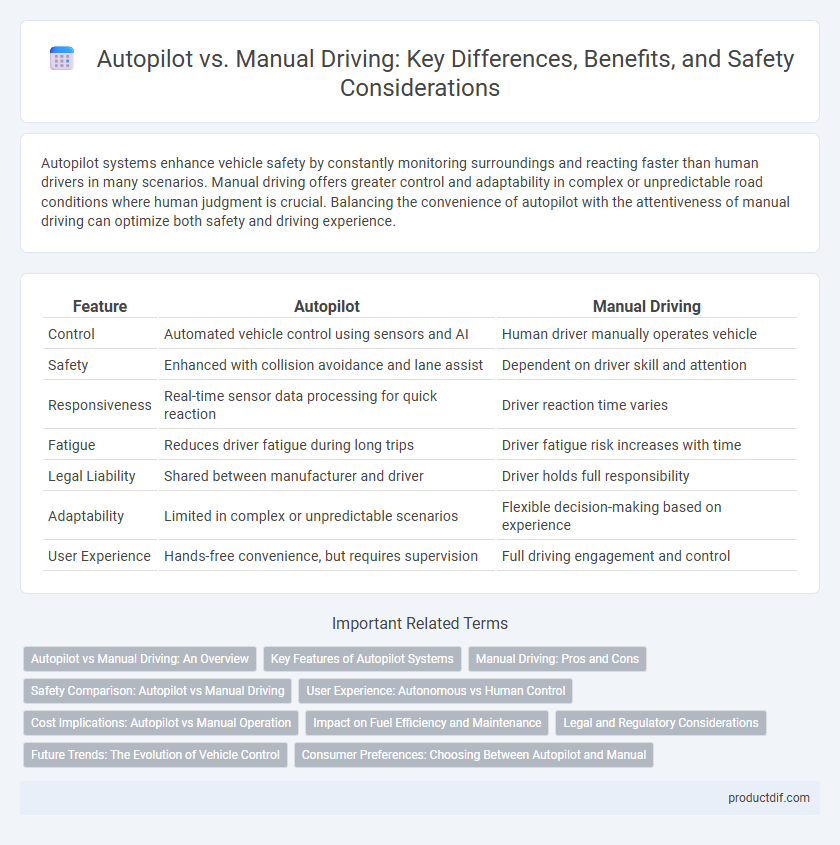Autopilot systems enhance vehicle safety by constantly monitoring surroundings and reacting faster than human drivers in many scenarios. Manual driving offers greater control and adaptability in complex or unpredictable road conditions where human judgment is crucial. Balancing the convenience of autopilot with the attentiveness of manual driving can optimize both safety and driving experience.
Table of Comparison
| Feature | Autopilot | Manual Driving |
|---|---|---|
| Control | Automated vehicle control using sensors and AI | Human driver manually operates vehicle |
| Safety | Enhanced with collision avoidance and lane assist | Dependent on driver skill and attention |
| Responsiveness | Real-time sensor data processing for quick reaction | Driver reaction time varies |
| Fatigue | Reduces driver fatigue during long trips | Driver fatigue risk increases with time |
| Legal Liability | Shared between manufacturer and driver | Driver holds full responsibility |
| Adaptability | Limited in complex or unpredictable scenarios | Flexible decision-making based on experience |
| User Experience | Hands-free convenience, but requires supervision | Full driving engagement and control |
Autopilot vs Manual Driving: An Overview
Autopilot systems utilize advanced sensors, cameras, and AI algorithms to enable vehicles to navigate and control speed with minimal driver intervention, enhancing safety and reducing fatigue on long drives. Manual driving relies on human input for steering, acceleration, and braking, offering greater control but increasing the risk of driver error due to distractions or fatigue. Comparing both modes highlights Autopilot's potential to improve traffic efficiency and accident reduction while acknowledging the necessity of driver vigilance and situational awareness.
Key Features of Autopilot Systems
Autopilot systems feature advanced sensor fusion combining radar, cameras, and ultrasonic sensors to enable real-time environment mapping and obstacle detection. Adaptive cruise control adjusts vehicle speed based on traffic flow, while lane-keeping assist maintains positioning within lane boundaries through precise steering inputs. Automated emergency braking and traffic-aware navigation enhance safety by reducing collision risk and optimizing route efficiency without manual intervention.
Manual Driving: Pros and Cons
Manual driving offers enhanced control and responsiveness, allowing drivers to adapt quickly to complex road conditions and unexpected hazards, which can improve safety in certain scenarios. However, it requires constant attention and can lead to driver fatigue, increasing the risk of human error during long trips or heavy traffic. While manual driving fosters skill development and engagement, it lacks the convenience and advanced safety features provided by Autopilot systems in modern vehicles.
Safety Comparison: Autopilot vs Manual Driving
Autopilot systems in vehicles utilize advanced sensors, machine learning algorithms, and real-time data processing to reduce human error, resulting in statistically lower accident rates compared to manual driving. Studies indicate that vehicles equipped with Autopilot features experience fewer collisions per million miles driven, particularly in highway scenarios where consistent speed and lane-keeping improve safety outcomes. Manual driving, while allowing for intuitive decision-making in complex environments, is more susceptible to distractions, fatigue, and reaction delays, contributing to higher incidences of traffic accidents.
User Experience: Autonomous vs Human Control
Autopilot systems offer a seamless driving experience by reducing driver fatigue and enhancing safety through real-time data processing and adaptive responses. Manual driving provides drivers with full control and immediate feedback, allowing for intuitive decision-making in complex or unpredictable situations. User experience varies significantly as autonomous driving prioritizes convenience and risk mitigation, while human control emphasizes situational awareness and personalized maneuvering.
Cost Implications: Autopilot vs Manual Operation
Autopilot systems in vehicles can reduce long-term operational costs by minimizing fuel consumption through optimized driving patterns and lowering insurance premiums due to enhanced safety features. Manual driving incurs higher expenses related to human error, increased fuel consumption from inconsistent driving behaviors, and potential accident-related costs. Maintenance costs may rise with autopilot technology due to complex sensor and software repairs, but these are often offset by savings in accident damage and fuel efficiency over time.
Impact on Fuel Efficiency and Maintenance
Autopilot systems optimize throttle and braking with precision, reducing fuel consumption by minimizing idling and harsh acceleration compared to manual driving. Consistent autopilot operation leads to less wear on engine components, brakes, and tires, lowering maintenance costs over time. Manual driving often results in variable fuel efficiency and increased mechanical stress due to inconsistent driving patterns and human error.
Legal and Regulatory Considerations
Autopilot systems in vehicles are subject to evolving legal frameworks that vary by jurisdiction, often requiring manufacturers to meet stringent safety standards and provide clear driver engagement protocols. Manual driving regulations typically impose well-established liability and responsibility on human drivers, emphasizing adherence to traffic laws and safe operation. Legal ambiguities persist around accidents involving autonomous features, prompting regulatory authorities to develop specific guidelines to address liability and data privacy concerns.
Future Trends: The Evolution of Vehicle Control
Autopilot technology is rapidly advancing with features like AI-powered decision-making and enhanced sensor fusion, promising greater safety and efficiency compared to manual driving. Future vehicle control systems will integrate real-time data analytics and V2X (vehicle-to-everything) communication to optimize traffic flow and reduce human error. Autonomous driving adoption is projected to accelerate, reshaping urban mobility and enabling smarter, more sustainable transportation ecosystems.
Consumer Preferences: Choosing Between Autopilot and Manual
Consumers weigh safety, convenience, and control when choosing between autopilot and manual driving modes. Autopilot systems, such as Tesla's Autopilot or Cadillac's Super Cruise, appeal to drivers seeking reduced fatigue on long trips and enhanced collision avoidance technology. Manual driving remains preferred by enthusiasts valuing direct vehicle control and situational awareness, especially in complex traffic or adverse weather conditions.
Autopilot vs Manual Driving Infographic

 productdif.com
productdif.com